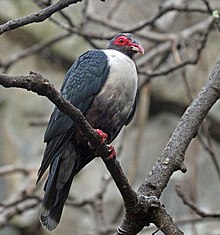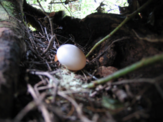Mountain pigeon
| Mountain pigeon | |
|---|---|

| |
| Papuan mountain pigeon | |
| Scientific classification | |
| Domain: | Eukaryota |
| Kingdom: | Animalia |
| Phylum: | Chordata |
| Class: | Aves |
| Order: | Columbiformes |
| Family: | Columbidae |
| Subfamily: | Ptilinopinae |
| Genus: | Gymnophaps Salvadori, 1874 |
| Type species | |
Gymnophaps albertisii
, 1874 | |
Mountain pigeons are four
The genus was originally
Taxonomy and systematics
The
Gymnophaps was initially thought to be most closely related to Columba, but the Australian ornithologist
| |||||||||||||||||||||||||||||||||||||
List of species
| Species in taxonomic sequence | ||||
|---|---|---|---|---|
| Common name | Scientific name[a] | Image | IUCN Red List Status | Distribution |
| Papuan mountain pigeon | Gymnophaps albertisii
Salvadori, 1874 |

|
LC IUCN[10] | 
|
| Buru mountain pigeon | Gymnophaps mada
(Hartert, 1899) |

|
LC IUCN[11] | 
|
| Seram mountain pigeon | Gymnophaps stalkeri
( Ogilvie-Grant , 1911)
|

|
LC IUCN[12] | 
|
| Pale mountain pigeon | Gymnophaps solomonensis
Mayr, 1931 |
LC IUCN[13] | 
| |
Description

All four species of mountain pigeon are medium-sized pigeons with long tails and wings, with lengths ranging from 33–38.5 cm (13.0–15.2 in) and masses of 259–385 g (9.1–13.6 oz). They have dull grey, white, or chestnut-brown plumage and extensive red orbital skin.[7] In most species, both sexes look similar, but the Buru and Papuan mountain pigeon show slight sexual dimorphism.[14][15] Mountain pigeons can be distinguished from other pigeons by the red skin around the eyes, the bluish-grey mantle, and the scaly patterning on the wings.[16]
Papuan mountain pigeons are 33–36 cm (13–14 in) long and weigh 259 g (9.1 oz) on average. Adult males have slate-grey
Buru mountain pigeons are 33–38.5 cm (13.0–15.2 in) long, and have blue-grey crowns and necks, darker slate-grey upperparts, and white to pale buff-pink throats and breasts that become buff-pink towards the belly. Females are smaller and have more dark red on the breast than the males.
Vocalisations
Mountain pigeons are generally silent, but have been recorded giving a deep woooooo m or woom, soft whistles, a wheezy vrrhu, and a quiet vruu.[7]
Distribution and habitat
Mountain pigeons are all found on islands in the Maluku Islands and Melanesia. The Papuan mountain pigeon is found on New Guinea, Yapen, the D'Entrecasteaux Islands, the Bismarck Archipelago, and Bacan.[7] The Buru mountain pigeon is endemic to Buru[14] and the Seram mountain pigeon is endemic to Seram.[18] The pale mountain pigeon is endemic to the Solomon Islands archipelago, where it is found on Bougainville, Kolombangara, Vangunu, Guadalcanal and Malaita.[7]
All four species in the genus inhabit hill and
Behaviour and ecology
All four species of mountain pigeons are highly
Mountain pigeons generally roost high in mountains and descend in flocks to feed in the mornings. While doing so, they can drop hundreds of metres in a single dive, making a loud whooshing noise with their wings that is distinctive of the genus. The birds fly low above trees while leaving the roost, but fly very high while crossing lowlands.[7]
Feeding
Mountain pigeons are
Breeding
A display flight has been observed during the breeding season in the Papuan and Seram mountain pigeons. In the Papuan mountain pigeon, one or two males consort with a female from an open perch overlooking a steep drop, after which one male launches himself and dives down before suddenly rising 25–30 m (82–98 ft) above the forest canopy with rapid wingbeats. The male then stalls at the top of this rise and plummets again before returning to his perch. This is repeated periodically, both males taking turns to display to the female.[7] Male Seram mountain pigeons perform a similar display, but fly lower, less steeply, and continue to fly forward after descending instead of returning to the perch immediately.[21]
The Papuan mountain pigeon's breeding season lasts from October to March in the Schrader Range, but it may breed throughout the year in other parts of its range. The pale mountain pigeon has been observed breeding from July to September.[7] The only known nest of the Seram mountain pigeon was seen in September.[22] Nothing is known about the Buru mountain pigeon's breeding.[14]
Mountain pigeons nests can be of two types: a shallow depression in the forest floor or short grass; and a platform of sticks placed at a height of several metres in a tree.[22] The Papuan mountain pigeon is thought to nest in a partially colonial manner.[7] The Papuan, pale, and Seram mountain pigeons all lay clutches of one white egg; the Buru mountain pigeon's clutch size is not known.[22]
Predators and parasites
Mountain pigeons have been recorded being
Status
The International Union for Conservation of Nature lists all four species of mountain pigeons as being of least concern due to their stable populations and sufficiently large ranges.[10][11][12][13] The Papuan mountain pigeon is common on New Guinea, but local populations can vary widely. It is generally uncommon on New Britain and New Ireland and is thought to also be uncommon on Bacan.[15] The pale mountain pigeon is also moderately common throughout its range and is very common on Kolombangara, where it roosts in flocks of hundreds.[17] The population of the Buru mountain pigeon was estimated at 43,000 in 1989 and is currently thought to be between 20,000 and 50,000.[14] The Seram mountain pigeon's population has not been estimated, but it is reportedly commoner on Seram than the Buru mountain pigeon is on Buru.[18]
Notes
- binomial authority (scientist who originally named the species) and the year in which the species was described. A binomial authority in parentheses indicates that the species was originally described in a genus other than Gymnophaps.
References
- OCLC 820904343.
- ISBN 978-1-4081-2501-4 – via Internet Archive.
- OCLC 1588421.
- OCLC 62578303.
- hdl:2246/4238.
- ^ Hutchinson, Robert; Rheindt, Frank (2007). "A photoshot odyssey through the confused avian taxonomy of Seram and Buru (southern Moluccas)". BirdingASIA. 7: 18–38.
- ^ OCLC 701718514.
- .
- PMID 17661233.
- ^ . Retrieved 2021-11-11.
- ^ . Retrieved 2021-11-11.
- ^ a b BirdLife International (2016). "Gymnophaps stalkeri". IUCN Red List of Threatened Species. 2016: e.T45448758A95156213. Retrieved 2021-11-11.
- ^ . Retrieved 2021-11-12.
- ^ S2CID 242670243. Retrieved 2022-02-07.
- ^ S2CID 243173287. Retrieved 2022-02-07.
- OCLC 936447561.
- ^ S2CID 243129535. Retrieved 2022-02-07.
- ^ S2CID 243013984. Retrieved 2022-02-07.
- S2CID 83564114.
- OCLC 5157014478.
- OCLC 1322699583.
- ^ OCLC 7150260576.
- S2CID 42031784.
- from the original on 2021-11-09. Retrieved 2022-02-10.


